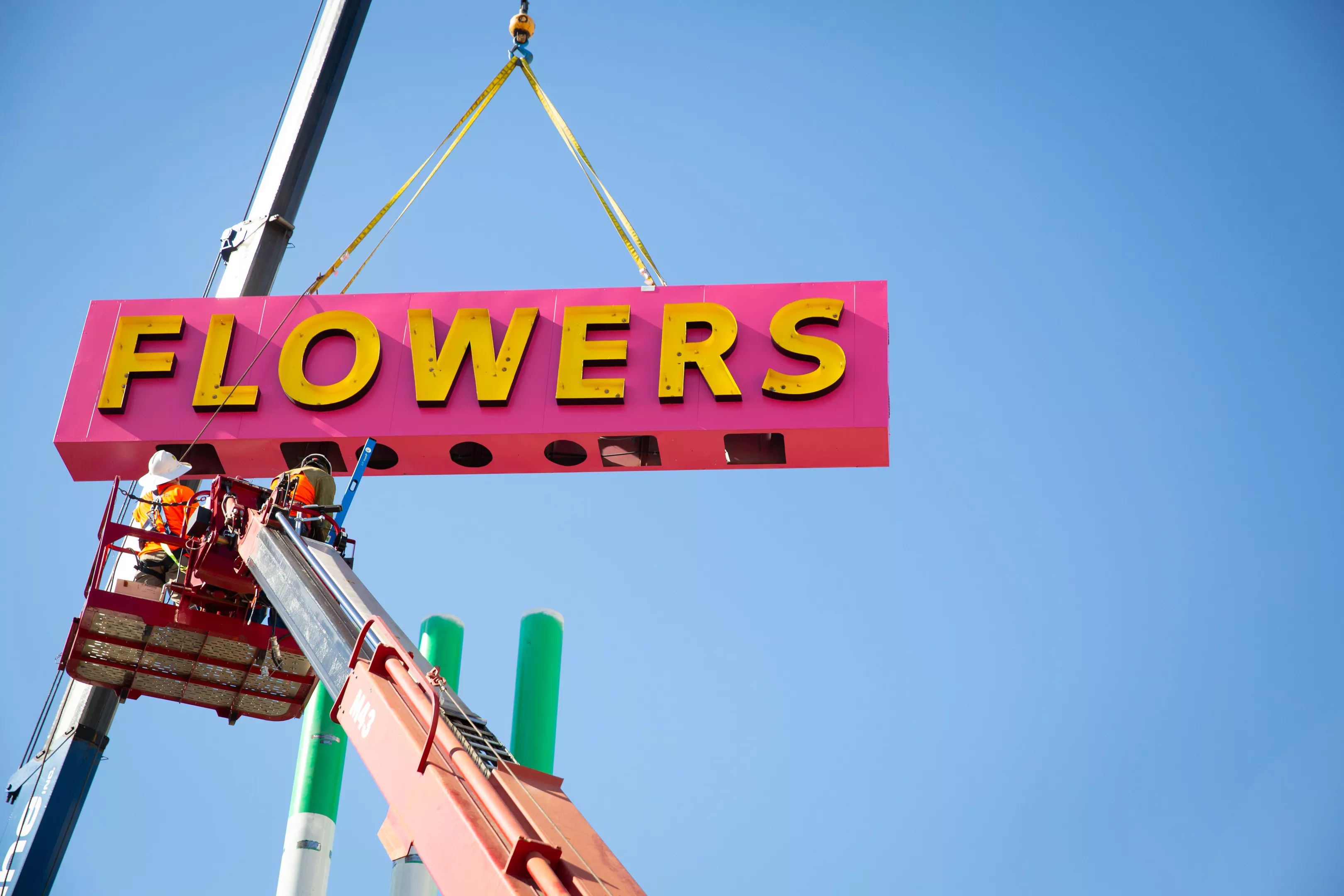
City of Mesa

Audio By Carbonatix
Once upon a time, downtown Mesa was drenched in the glow of neon lights. Businesses like motels, diners and cocktail lounges buzzed with vibrant color as their illuminated signs beckoned the public.
Later this week, a handful of these relics from a bygone era will shine once more.
Mesa’s new Neon Garden at downtown community event space The Post, 26 N. Macdonald, will be unveiled during a public dedication and lighting ceremony on Thursday evening. The open-air display showcases five restored vintage neon signs from iconic Mesa businesses, including Bill Johnson’s Big Apple.
The collection also includes a replica of the Starlite Motel’s iconic Diving Lady, the only animated neon sign left in the Valley.
This year, make your gift count –
Invest in local news that matters.
Our work is funded by readers like you who make voluntary gifts because they value our work and want to see it continue. Make a contribution today to help us reach our $30,000 goal!
The Neon Garden is a collaboration between the city and the Mesa Preservation Foundation. The project was partially funded through a 2018 voter-approved bond intended to support cultural efforts, according to Mesa officials.
The vintage signs on display at the garden – including pieces from current businesses like Watson’s Flowers and bygone institutions like Bill Johnson’s – were restored by the foundation. Each offers a glimpse into Mesa’s midcentury past.
Vic Linoff, the foundation’s president, says the project has been more than a decade in the making.
“It’s been 15 years, but the job has been absolutely monumental,” Linoff says. “It required the restoration of five signs, (and) now people can know and understand the history of these signs and the role they played in Mesa.”
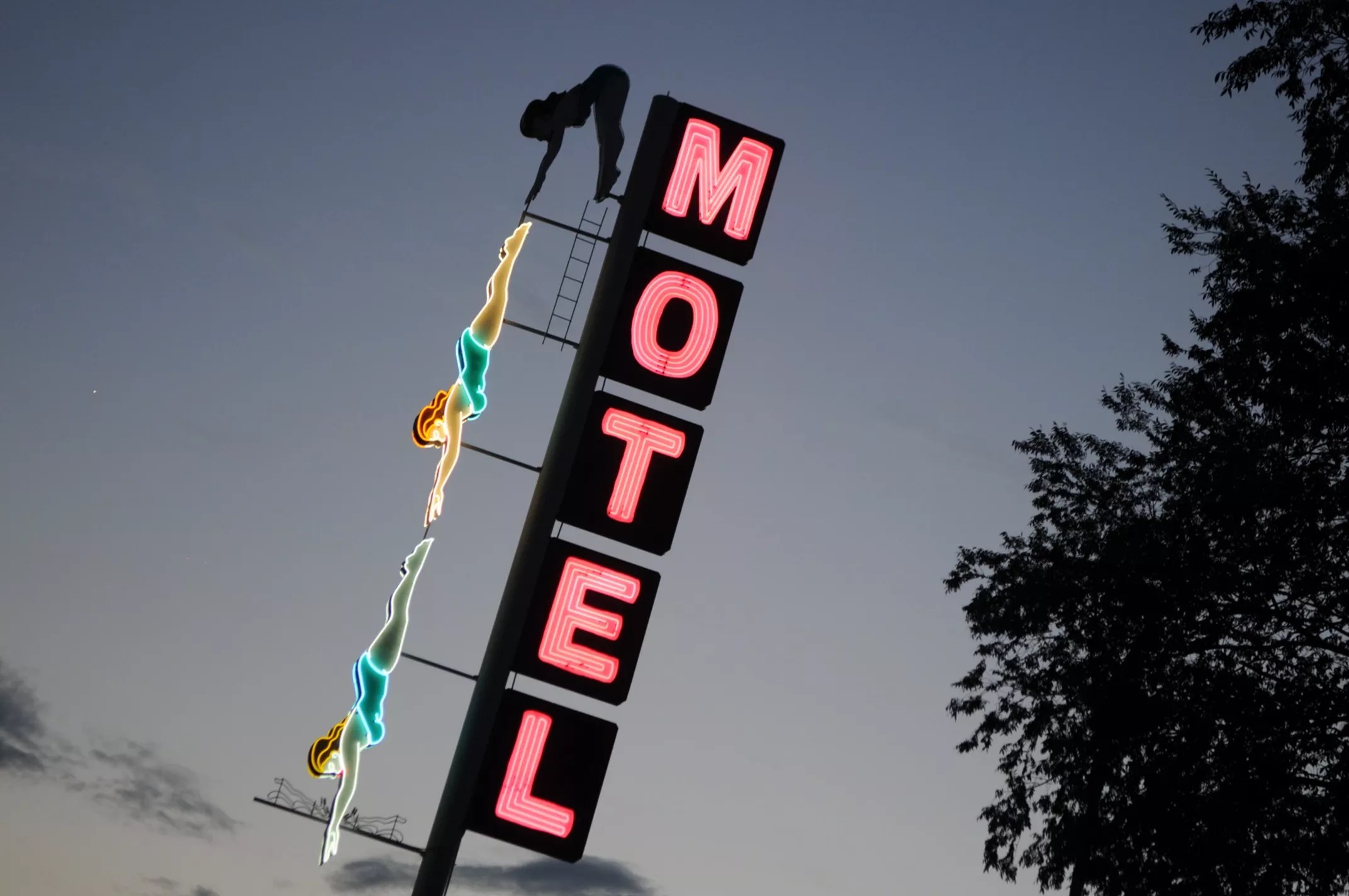
The iconic Diving Lady at the Starlite Motel along Main Street in Mesa, which was restored in 2013.
Benjamin Leatherman
Sign of the times
Mesa’s neon history stretches back more than 80 years. During the post-war boom, glowing signs became a staple of businesses along the Valley’s highways and thoroughfares.
From the 1940s through the ’80s, several major highways – including the old U.S. 60 – ran along Main Street, bringing travelers through downtown Mesa.
“All of these highways converged on Main Street, ran through Tempe and went into Phoenix,” Linoff says. “It created a whole new industry, because cars were able to travel long distances and it opened up those roadsides for many kinds of businesses: lodging, tourism, food, auto repair, gas, all sorts of things.”
Many of those businesses boasted colorful, buzzing neon signs outside. At the height of midcentury motor culture, Linoff estimates downtown Mesa had “well over 100 signs.”
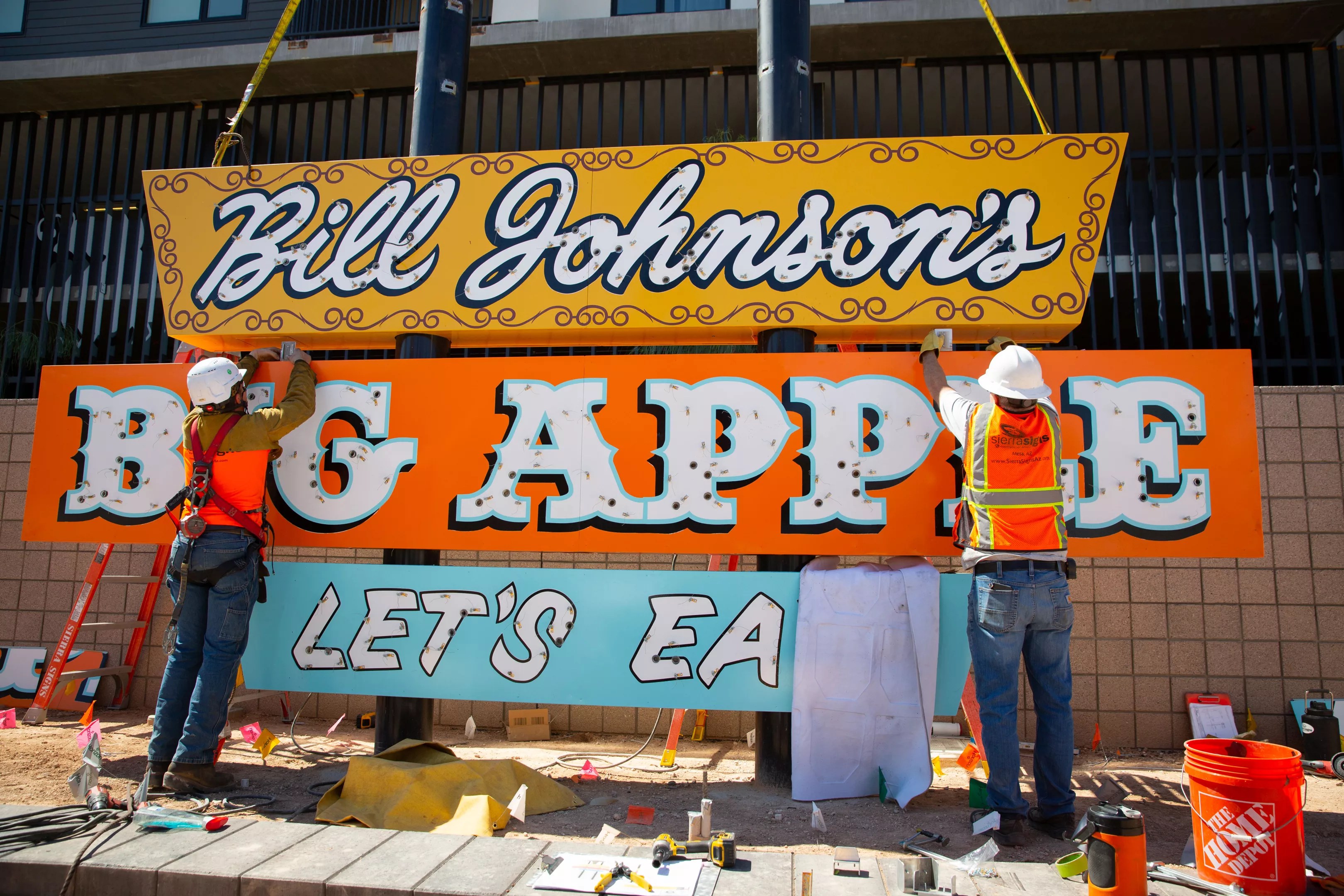
City of Mesa workers with the restored neon sign for Bill Johnson’s Big Apple, which dates back to the 1960s.
City of Mesa
“There’s a certain beauty to neon,” Linoff says. “It was incredibly bright, visible from far away, long-lasting and offered amazing potential for artistic expression. So you can imagine people coming down the road after a long day of driving would see the signs from great distances and want to stop.”
During the ’50s and ’60s, Mesa’s Main Street was home to some of the Valley’s most iconic neon signs, including those at well-known landmarks like the Buckhorn Baths Motel. Some signs were even animated, such as the towering Diving Lady at the Starlite Motel near Main Street and Lindsay Road, which depicted a swimsuit-clad woman diving gracefully into a pool below.
Neon’s popularity in Mesa and across the country began to fade in the 1970s. In the early ’90s, U.S. Highway 60 was rerouted a few miles south to the Superstition Freeway, and cities such as Mesa shifted their focus to beautification and urban renewal projects.
“(Neon) went through a period of great decline,” Linoff says. “Over time, it got the reputation as being garish or being associated with unsavory businesses. So many cities, including Mesa, started banning neon as signage in the 1990s.”
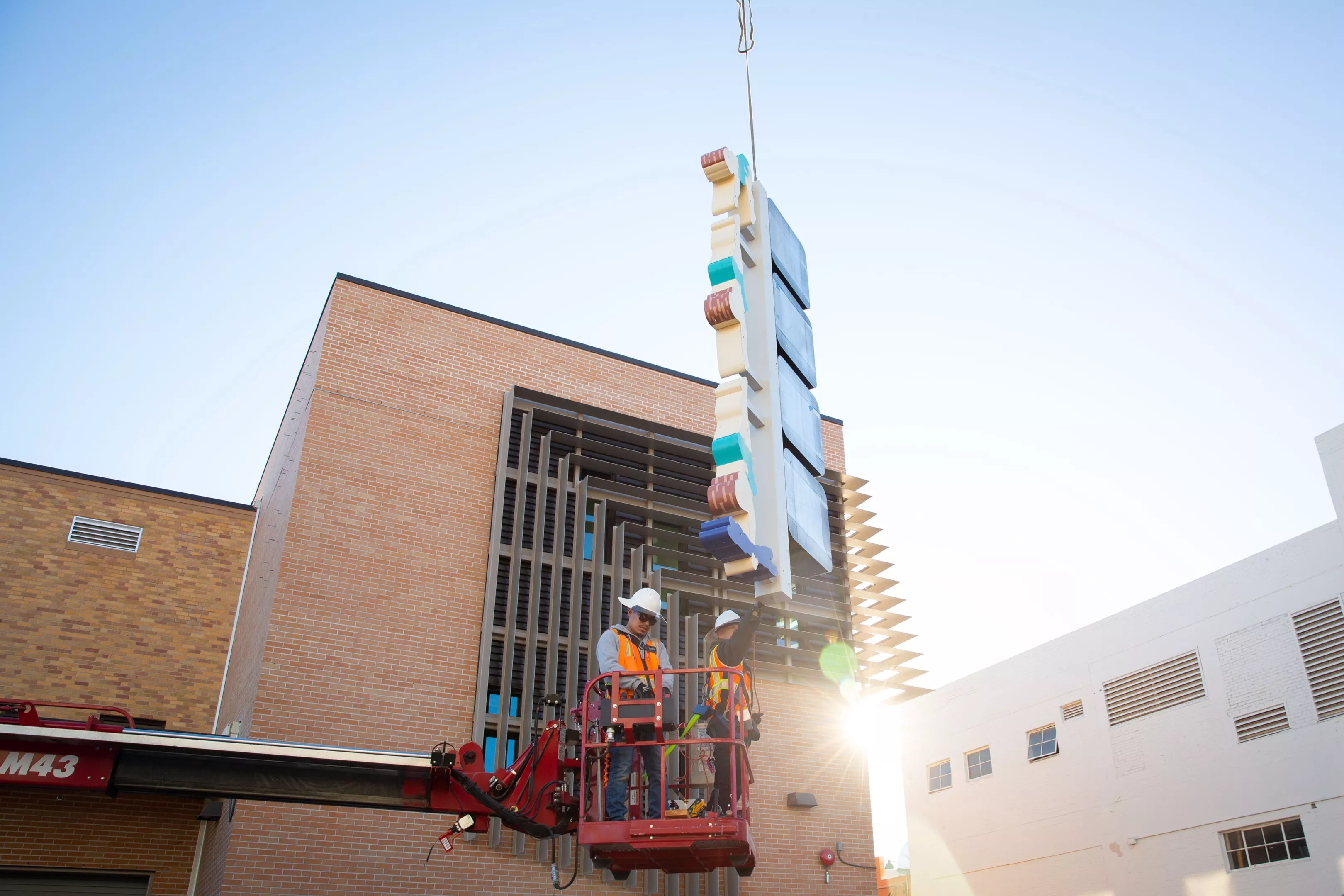
City of Mesa workers install a replica of the Diving Lady sign created by local neon artist Larry Graham.
City of Mesa
The return of the Diving Lady and neon’s resurgence
By the 2000s, only a couple dozen neon signs remained along Mesa’s Main Street. Once vibrant and iconic, many had faded into disrepair as exposure to the elements over the decades took their toll. Some signs broke down and were never repaired. Others were removed and replaced with modern designs or LED displays.
In 2010, a microburst toppled the beloved the Starlite Motel’s Diving Lady. Local preservationists weren’t ready to let the sign fade into history, though. Over the next few years, the Mesa Preservation Foundation raised funds to pay for a $125,000 restoration of the iconic sign, which returned in 2013.
“It’s such an iconic piece of history that people felt it was something worth saving,” Linoff says.
The Diving Lady’s restoration coincided with a neon sign renaissance across the Valley and elsewhere. Since 2014, numerous local businesses have re-embraced the art form and use neon signage, including in Gilbert’s Historic Heritage District and midtown Phoenix’s Uptown Plaza.
“(People) have really come to embrace the value of neon as a piece of history,” Linoff says.
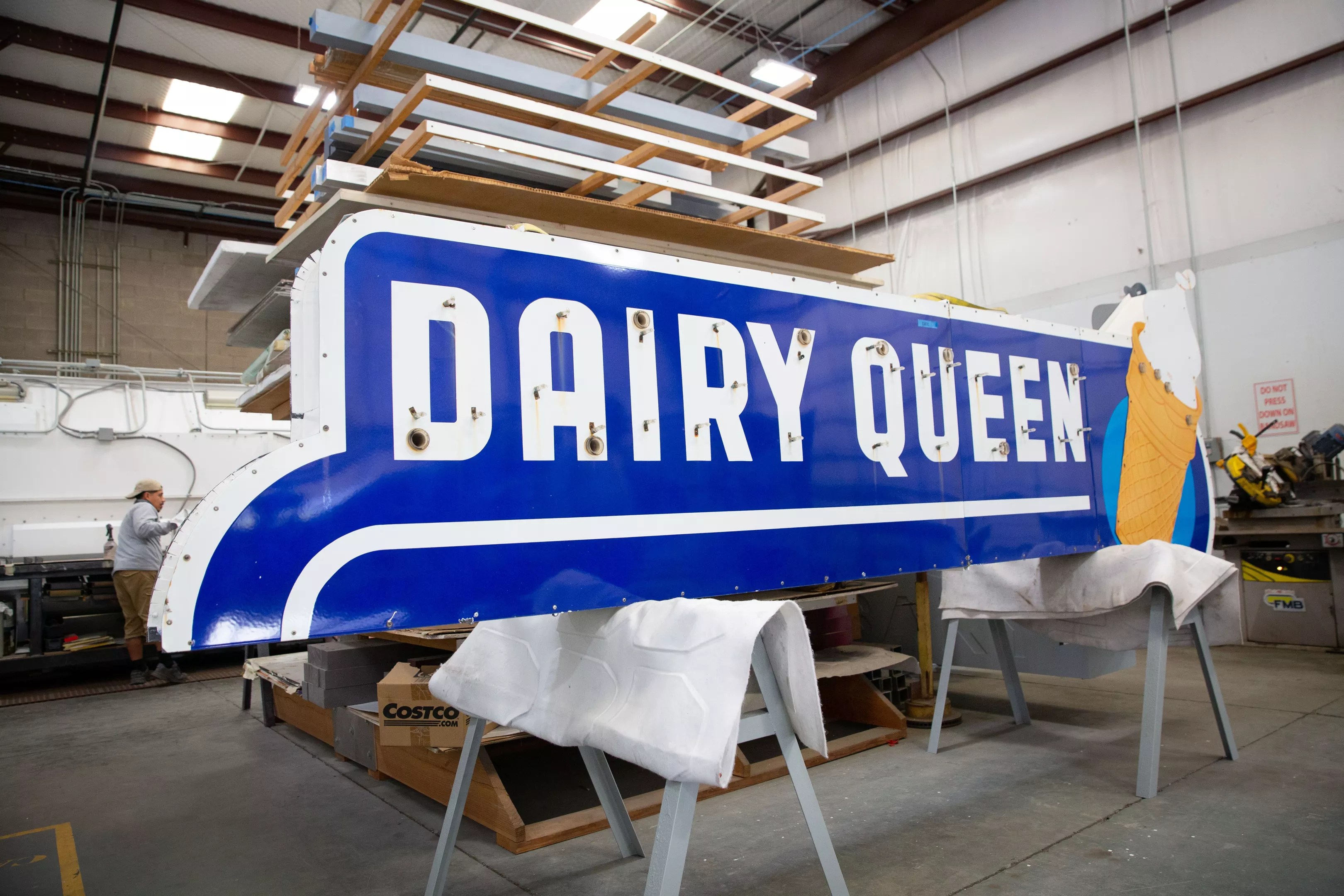
The vintage neon sign for a Dairy Queen that operated along Main Street in Mesa for decades.
City of Mesa
Old signs, new glow
Linoff says Mesa’s Neon Garden grew out of a similar desire to preserve the city’s history and heritage. When plans emerged in the early 2020s to transform a historic U.S. post office into The Post, a downtown community event space, city officials saw an opportunity to showcase vintage neon signs. They began working with the Mesa Preservation Foundation, which had spent years collecting signs from Mesa’s past.
“When they were discussing how to best use The Post, it turned into how this would be a great place to begin showing off neon,” Linoff says. “The foundation already had nearly two dozen signs and we still didn’t have places to relocate them.”
The Neon Garden will showcase six signs outside The Post, each a glowing piece of Main Street history. There’s the towering, bloom-covered display from Watson’s Flowers, which came down in 2014. An elongated porcelain enamel sign from an old Dairy Queen that operated for decades is adorned with a soft-serve cone. And the Bill Johnson’s Big Apple sign offers a country-fried charm, complete with rustic lettering and the now-defunct local restaurant chain’s hearty slogan: “Let’s Eat.”
Other pieces in the collection include signs for Mesa’s Smiley Ford, which later became Berge Ford in the 1980s, and the historic Frontier Motel.
At the suggestion of former Mesa City Manager Chris Brady, local neon artist Larry Graham was commissioned to create a 15-foot-tall replica of the original 60-foot-tall Diving Lady sign. Like the original, it’s animated.
“Chris thought, ‘Why don’t we pay homage to what started it all?'” Linoff says.
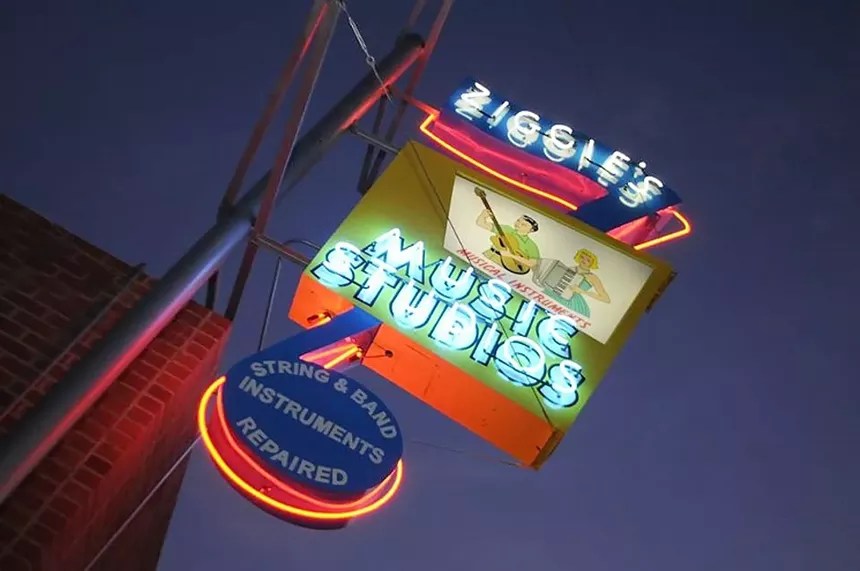
The neon sign for the now-defunct Ziggie’s Music in Phoenix, which will eventually make its way to downtown Mesa.
Benjamin Leatherman
Linoff says other restored neon signs from the foundation’s collection will be displayed in the Neon Garden and at various locations around downtown Mesa. It will include historic signs from across the Valley, such as the one from Ziggie’s Music, the beloved midtown Phoenix retailer that closed last year.
“They may be on side streets or near businesses, but they’ll all be (displayed) downtown. The foundation will serve as a facilitator to help make this happen,” Linoff says. “The way we look at it is we don’t want to own these signs. And once they’re all in place and they’re lit up, they’ll belong to all of us.”
Neon Garden dedication ceremony. 7 p.m. Thursday at The Post, 26 W. MacDonald in Mesa. Admission is free.